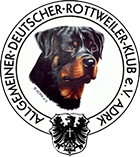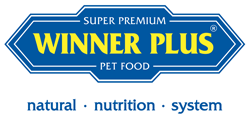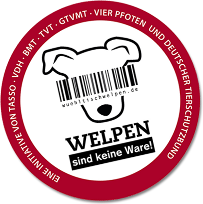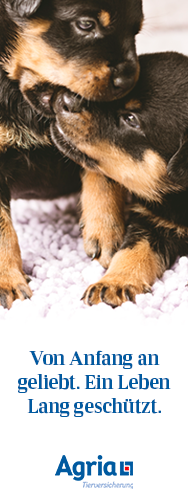| ADRK |
| Allgemeiner Deutscher Rottweiler-Klub e.V. |
Raw or cooked - hygienic aspects of fresh feeding
Nowadays, many dog owners feel the need to feed their dog with fresh ingredients. Animal products are often fed raw, for example in the form of BARFens or Preyens. Meat and other animal parts as well as eggs are usually fed raw, while raw dairy products play a subordinate role in dog nutrition. There is controversy as to whether this type of feeding is a suitable form of dog nutrition. One aspect that will be examined in more detail here is hygiene when feeding raw animal products.
What can be in raw meat?
Raw animal products are normally not sterile, but always contain a proportion of germs. Some of them can be regarded as potential pathogens. Bacteria such as salmonella, Escherischia coli or listeria and parasites such as tapeworms or toxoplasms are important. The Aujeszky's virus is a dangerous viral disease. In raw eggs, bacterial pathogens such as salmonella play a predominant role. Some infectious agents may already be present even in fresh meat suitable for human consumption. In the case of prolonged or improper storage of animal feeds, all types of germs can also multiply and contaminate the food. This must be taken into account in particular for frozen products sold only for animal consumption.
Can my dog get infected with it?
Aujeszky's viruses transmitted through raw meat cause fatal infections in dogs. However, since German pig herds are now Aujeszky-free, meat products from abroad and wild boars are considered to be the main carriers. Bacteria and parasites from raw animal products often only lead to symptom-free infection in healthy dogs, without the dog appearing ill. However, it can transmit the germs to other pets or humans. Special care should be taken with puppies and young dogs, pregnant and nursing bitches, dog seniors as well as sick and weakened dogs, as their immune system is not fully developed and they themselves can easily fall ill with one of the infections mentioned.
Who else is at risk?
Some of the pathogens transmitted by raw meat leave the dog with latent infections, which then become so-called permanent excretors. Affected dogs can also infect humans. Here, too, children, pregnant women, elderly as well as sick and immunocompromised people are particularly at risk. Especially toxoplasmosis, which is transmitted by infected cats as well as raw meat, represents a great danger for pregnant women and the unborn child. Salmonella and other bacteria can endanger children and elderly as well as immunocompromised people. Sources of infection are, on the one hand, the excreta of dogs in the environment, for example near playgrounds or playgrounds, the dog itself, as well as lying areas and places at home where it frequently stays.
However, human infection is also possible through direct contact with contaminated meat during meal preparation or feeding. Also with the improper cleaning of cutting boards, cutlery or dog bowl it can come to the transmission. If it is possible for the dog to carry raw meat parts around in the living area, contamination with germs can occur in various places.
How can I avoid infection?
From a medical point of view, it is advisable to completely avoid raw feeding and always heat fresh meat well. Sufficient cooking is achieved by cooking or frying for a short time when the meat is no longer pink. Nutritionally, cooked fresh meat does not have any disadvantages compared to raw fresh meat.
Those who do not want to do without raw feeding should consider a few points. Only dogs that are fully grown and healthy should be fed with raw meat. There should be no persons susceptible to infection such as children, pregnant women, elderly or sick people living in the household. Raw feeding is also not suitable for therapy dogs that come into contact with these groups of people. It should also be noted that chewing items that are only dried and not heated can also be a source of infection. As with all dogs, the dog's excrements should be carefully removed from public places.
In order to reduce the transmission of germs to the dog, care should be taken to ensure hygienically harmless starting products. In the case of meat sold for human consumption, the general hygiene rules, which also apply to humans, are sufficient: Poultry and game meat should not be eaten raw, beef only when fresh. The consumption of raw pork meat is strictly forbidden for dogs, however, heated pork meat is very suitable for feeding dogs. When preparing raw meat, care must be taken to ensure perfect kitchen hygiene: Cutting boards and cutlery as well as contaminated bowls including the dog bowl must then be thoroughly cleaned with hot water (over 60°C). The hands must also be thoroughly cleaned after preparation. These rules also apply to the preparation of meat which is subsequently heated. Freezing for several days helps against some parasites, but not against bacteria or viruses. In the case of raw frozen meat sold specifically for feeding to animals, care must be taken to ensure an uninterrupted cold chain and proper storage, and the quality of the meat must be checked before each feeding. Dogs should not be allowed to carry raw meat away from the feeding place. The feeding area should be easily wiped clean and, depending on contamination, thoroughly cleaned immediately afterwards to minimise the spread of germs with the paws or the dog's own shoes.
Special care should be taken when feeding whole prey animals or larger parts of animals that are not completely eaten by the dog during a meal. The prey animals are to be regarded from the outset as contaminated with germs, especially in the case of prey animals that have not been gutted. When the prey is picked up, the head and paws of the dog are clearly contaminated with blood, meat juice or intestinal contents. Administering it at home is therefore generally not advisable. If remaining booty remains are to be stored for a later meal, they should be well packed and stored in a cool place. In any case, there is a clear risk of infection from the dog and contamination of his whereabouts. Therefore, the principle of avoiding contact with susceptible people is particularly important here.
Is there a right way?
Who observes the above mentioned hygiene rules and also pays attention in principle to a hygienic handling of the dog as well as raw animal products in the kitchen, already contributes to a clearly reduced risk of infection. In addition, gentle but complete cooking ensures a hygienically safe quality of the fresh food. If the fresh rations are arranged according to the individual needs of the dog, for example by a professional ration calculation, also an adequate nutrient supply is secured. Under these conditions, fresh feeding represents an ideal diet for our domestic dogs.










